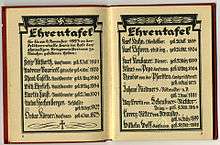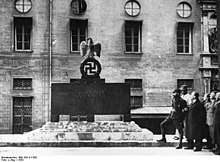Blutzeuge

A roll of honor list for members killed in the Hitler-Ludendorff Putsch, in a 1935 NSDAP publication.

An "Ehrentempel" at Königsplatz, 1936.

Nazi memorial site for Blutzeugen, which could be bypassed by the "Drückebergergasse" ("quitters' alley").
Blutzeuge (English: blood witness) was a term used in Nazi propaganda in the 1930s–1940s in Germany depicting a hero cult of "fallen" Nazis who had been killed during the Nazi ascent to political power. An early Nazi usage of the term was Hitler's dedication at the start of Mein Kampf, which he dedicated to the sixteen National Socialist members killed in the 1923 Beer Hall Putsch.[1]
References
- ↑ Andreas Daum; Christof Mauch (26 December 2005). Berlin - Washington, 1800-2000: Capital Cities, Cultural Representation, and National Identities. Cambridge University Press. pp. 145–. ISBN 978-0-521-84117-7.
This article is issued from
Wikipedia.
The text is licensed under Creative Commons - Attribution - Sharealike.
Additional terms may apply for the media files.